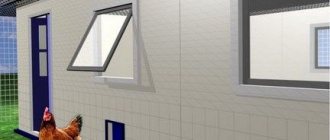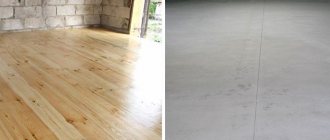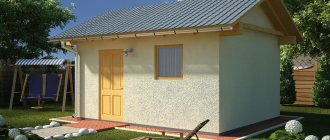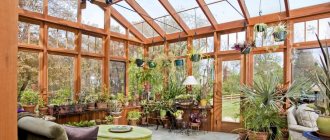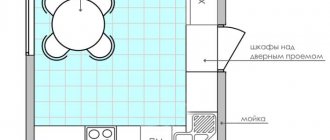Perch
Of course, roosting is a very obvious component of any chicken coop. But it’s also a matter of making the perch poles correctly. They should not be too thin or thick: in the first case, the poles may bend or even break under the weight of the chickens sitting on them, and in the second, the birds will not be able to grasp them with their paws and risk falling from the perch. Ideally, the poles are made of timber with a cross-section of 4x7 or 5x6 cm. Another important point is that the poles must be smooth: first, to give a rounded shape, the beam is trimmed, then sanded with sandpaper to smooth out burrs and protrusions.
If you are not used to throwing away old things, look for shovels with handles of the required diameter: they are ideal for making poles.
- Ideas for a garden using unnecessary things: 10 life hacks
Don’t rush to throw away old things: they can serve you in a different capacity for many more years!
Chicken nests
Your birds will be pleased to lay eggs in places specially designated for this - so don’t be lazy to equip the chicken coop with nests. To install them, choose a spacious place without drafts. The nest should have a stable structure with a small ladder leaning against it so that the bird can freely get to the nest and back.
The depth of the nest should be at least 40 cm, the width and height should be at least 30 cm. The distance to the floor should exceed 50 cm. Typically, there should be about half as many nests in a chicken coop as there are chickens, but in extreme cases, four chickens can lay in one nest .
- 10 reasons why you shouldn't throw away eggshells
Unusual ways to use eggshells at home and in the country.
Features of construction
A chicken coop is a building designed for keeping and raising poultry.
The basic requirements for a poultry house are as follows.
- The norms assume that 3–4 individuals are present per 1 m² at the same time. Laying hens should move freely around the coop. If there are only two chickens, at least 3 m² is required.
- Birds require exercise unless they can move freely around the yard. The dimensions of the compartments are at least 15 m². A canopy is built over part of the walking area so that the birds have somewhere to hide from the rain.
- It is better to build a chicken coop on a hill to avoid dampness and leakage.
- They construct a utility block from brick, foam concrete, and cinder blocks. However, the best option is wood, as this material retains heat much better. The brick structure needs serious insulation.
- Windows are placed on the south side to provide natural light. Windows should open to ventilate the room.
- It is imperative to equip the chicken coop with perches and nests for laying hens.
The better equipped the chicken coop, the less often the owner will have to worry about the condition of the chickens.
Feeders
This is also a self-evident thing that some owners of private farmsteads for some reason ignore. It is more pleasant for any pet to eat food from a dish than to collect it on the ground. Bird is no exception. It is recommended to feed her twice a day, but it is better if some food remains in the feeder at night.
Remember that mice also periodically enter the chicken coop, forcing the chickens to “share” food with them. Especially for these uninvited guests, leave a mouse trap in the secluded corners of the poultry house where the chickens cannot reach.
- Cute little animals? All the harm of mice and rats in the country and in the house
Man is constantly fighting with the mice and rats that live next to him. After all, few animals are capable of causing so much harm.
Interesting design ideas
Making a chicken coop with your own hands is a fascinating process that allows you to bring many interesting ideas to life. The result will be not only practical, but also original construction. Among the implemented ideas for a chicken coop, there are many beautiful and original models that are worthy of becoming a source of inspiration:
- An example of not only a comfortable, but also a stylish bird house, which can not be hidden in the depths of the garden, but placed right in the yard. Highly located nesting sites always remain clean. Double side doors make cleaning easy for owners. The building has an elegant, decorative appearance thanks to white walls, a dark roof and contrasting details.
Comfort in a modern style Source i.pinimg.com
- The owners of these birds approached the issue of lighting the chicken coop in a non-standard way, not sparing a chandelier in the Art Nouveau style. Extending daylight hours in winter will invigorate the birds, which will have a better effect on the number of eggs. The main thing is to choose light bulbs in the warm yellow spectrum, reminiscent of the sun.
Unexpected, but why not? Source image.hnol.net
- Sometimes it is easier to reconstruct an old building than to start construction from scratch. In a previous life, this chicken coop was a home for gardening tools.
Cozy and safe Source livelihoodtechnology.org
- Mobile chicken coop on wheels. Thanks to its neat appearance, it can be placed anywhere.
Always in the right place Source roomadness.com
For a large company Source www.thehenhousecollection.com
- A fun project that kids will love.
Thought out to the smallest detail Source trevormade.com
- The appearance of the chicken coop is especially important in small areas, where it often has to be placed in plain sight. The house, made in the style of the other buildings, became a decoration of the landscape.
When you want creativity Source 3.bp.blogspot.com
For three birds Source farm5.staticflickr.com
Water and drinking bowls
Set up a water bowl with water at room temperature in the coop. Check the water several times a day to ensure it is clean. Change the fluid if necessary.
Feeders and drinkers should be cleaned at least once a month. They are washed generously with water and a disinfectant. Before the start of the cold season, as well as after its end, the poultry house should be thoroughly cleaned.
- Reboot for the chicken coop: getting the house in order after winter
Chickens are unpretentious birds. But they won’t refuse a comfortable chicken coop either. What do laying hens need to be happy and healthy?
Photo ideas for exterior decoration
On a plot with pink flower beds and a classic house, a romantic white poultry house looks just right
A chicken coop made of unpainted wood looks natural in the garden
If you paint the facade of the poultry house in contrasting colors, it will look much more attractive
Such a chicken coop will seem appropriate next to a half-timbered house
A summer enclosure for chickens, reminiscent of a bungalow, can be assembled from the remains of the construction of the main house
Stern shell
In addition to balanced feed, birds also need additional nutrition. Its most important element is the feed shell. Thanks to it, the birds’ diet is enriched with calcium, they get sick less and deliver eggs with strong shells to your table. Therefore, a bowl with a feeding shell must be present in the chicken coop.
A laying hen should receive at least 130-180 g of balanced nutrition per day. Chalk, bone meal, and fish meal should always be available in the public domain. In addition, it is advisable to provide the birds with at least a few hours of open range to collect worms, larvae, roots and greens.
- What to feed chickens to help them lay eggs better
Have you decided to have laying hens? Find out what to feed them in advance to ensure you have eggs all year round.
What is a portable chicken coop
A mobile house for chickens has a lot of advantages, the most important thing is that it can be quickly moved to a new place with fresh herbs.
You can consider the following advantages of such an object:
- Birds will receive worms in addition to regular grass and food;
- You will have to buy less special food, since your pets will have a natural diet;
- There is no need to constantly change the flooring;
- Such a structure is easier to build and remove if necessary.
There is only one drawback - small capacity. However, for those who consider breeding as a seasonal hobby, this is an ideal option.
The photo of the chicken coop shows how simple the design is even for a beginner.
It is worth noting that such poultry houses can be divided into several groups according to the method of movement:
- Manual;
- Wheeled.
Manual movement will be easy if the coop is designed as a separate structure for the chickens. But the second option is more suitable for keeping adult chickens.
Coals and ash
It is equally important to provide the bird with coals and ash. The coals are intended to cleanse the stomach - chickens know this and happily peck at the natural “medicine”. They also love to bathe in ashes: in this way, birds clean their feathers and get rid of pests - lice, fleas, bedbugs, ticks and other parasites.
- Country house: how to recognize that a chicken is sick - first aid and prevention
We talk about the most common problems that chicken owners may encounter.
Grass, sand, small stones
These components, oddly enough, are also part of poultry feed. With them she not only enriches her diet, but also helps herself digest food. And since in winter it will be more difficult for her to find all this, make sure that everything she needs for a balanced diet is in the chicken coop and she doesn’t have to go far to get it.
- Dacha farmstead: the best breeds of laying hens for the dacha
We tell you what breeds of chickens you should pay attention to in order to get a lot of eggs during the summer season.
Preliminary preparation
Before the actual process of building a chicken coop, you should carefully consider every aspect of the actions and requirements. To begin, design the future structure and decide on the materials, location, shape and type of chicken coop.
Chicken coop design
Determining the required area of a structure is key when drawing up a construction plan. Not only the chicken coop itself is taken into account, but also the area for walking the chickens.
When developing a project, pay attention to the following points:
1Location of the structure
Under no circumstances should the place be in a low area. There are many reasons for this:
- after rains, water will accumulate there;
- the place itself will always be damp and dry out slowly (atmospheric moisture is concentrated there);
- in the lowlands the morning fog lasts the longest, etc.
It makes the most sense to place the structure on a small hill.
2 Chicken coop area
Dimensions are calculated individually. For every 5 laying hens, a minimum of 3 square meters must be allocated. m. Only in such conditions will normal coexistence and development of individuals be ensured. That is, the total size of a chicken coop for 5 chickens with such requirements will be 1.5 x 2 m (excluding the exercise yard).
If the chicken coop is being built for only 2-3 chickens, then the area may be even smaller. Premises of 1 sq. m will be more than enough.
The area for walking chickens should also be created taking into account the number of individuals. For the already mentioned 5 chickens, about 6-7 square meters are allocated. m of walking space. The more active the chickens’ lifestyle, the higher their egg production rate will be.
3Protecting the walking area
Wind protection should be provided for the walking area. An canopy installed over the enclosure, which will also protect the chickens from sunlight, rain and predators, will ideally cope with this task.
4Location features
It is strictly recommended to install the chicken coop on a hill. It can be created using an embankment made of layers of sand and crushed stone of the middle fraction. In addition to the stated benefits of this arrangement, it will also act as an obstacle for predators. Additional protection will be laying a layer of clay mixed with broken glass on top of the embankment.
5Ceiling and windows
Windows or doors provide natural light during the day. A reasonable solution would be a glazed door, but all this needs to be installed on the south-eastern side of the chicken coop - on this side the sun will illuminate the building the longest.
If the window is separate from the door, it should be installed at a height of 1.1-1.2 m from the floor, and the size should not be less than 50 x 50 cm. The ceiling rises to a height of 2-2.2 m so that there is a large volume of air space for chickens.
6Remote sockets
It is wiser to install nest extensions outside the coop so that they extend beyond its boundaries and have a size of 40 x 40 cm (minimum). The lid should lift easily so you don't have to go inside the coop to pick up the eggs.
Choosing a chicken coop
To build a good structure, you need to be responsible when choosing a chicken coop. This process depends on the following factors:
1Breed of chickens
All chickens are divided into 2 large groups: laying hens and meat chickens. For laying hens, space, lighting, fresh air and the opportunity to walk are important. In such conditions they will lay many eggs almost all year round.
But meat breeds should be kept as close together as possible so that they cannot walk around the chicken coop one more time and lose weight. Such breeds are kept only during the warm season, which means there is no need to heat the chicken coop.
2Type of walking
The walking area can also be of two types: open and closed. What was mentioned earlier are closed areas. They are good if the chicken coop itself is located in close proximity to a forest or fields. That is, where there is a danger of attack by predators.
With open range chickens leave the coop and walk around a large area, pecking at fresh grass. This will have a positive effect on their comfort, but there is also a risk of contracting a disease or being harmed by weasels, rodents and other predatory animals.
The choice of chicken coop also depends on this, since the absence of an enclosed run frees your hands when creating a building. And its necessity, on the contrary, forces us to design the future structure more compactly.
3 Number of chickens
The more chickens, the larger the coop you will need. Experts in breeding and keeping chickens advise allocating 3 square meters for 5 chickens. m of space. Accordingly, as the number of individuals increases, the size of the structure should also increase. This is worth paying special attention to, because it is possible to redo the roof or walls, but expanding the total area will be extremely problematic.
Every poultry farmer should remember that you should never completely copy a finished chicken coop design, even if it is executed flawlessly. If you forget about at least one individual, but important factor, the negative consequences will be significant.
Materials and tools
The materials for a homemade chicken coop will be needed:
- foam blocks;
- wood;
- old window frames;
- cement;
- crushed stone;
- bars;
- plywood;
- brick;
- cinder blocks or shell rocks.
Foam blocks are the best choice for construction due to ease of installation. They also retain heat well, but their cost is significantly higher than other materials.
The most economical option would be to build a chicken coop out of wood. Moreover, the appearance of a wooden structure will fit perfectly into the countryside. Wooden chicken coops are extremely environmentally friendly.
Perches should be sanded using sanding devices. Also, all wooden parts are treated with impregnations against fire, insects, mold and rot. For this purpose, only environmentally friendly liquids are used.
To build the walls of the chicken coop, you can use brick or cinder block. These materials will cost several times less than foam blocks, and their strength and durability are quite satisfactory. The only negative is that brick chicken coops need to be provided with additional insulation.
As for the roof, it can be made from:
- slate;
- corrugated sheets;
- metal tiles.
Both for the chicken coop itself and for the chickens, the material from which the roof is made is absolutely unimportant. Therefore, you should select the most economical option that will provide warmth and not allow moisture to pass through. And to insulate the roof you will need rolled insulation or expanded clay.
When building a chicken coop you will need the most standard set of tools:
- hammers;
- nails/screws;
- screwdriver;
- saw;
- shovel;
- roulette;
- axe;
- Master OK;
- plane.
All of the above are basic tools that will definitely come in handy. However, it is impossible to say with certainty whether all this will be enough, since each structure is built according to individual requests, drawings and requirements.
Additional materials that may be useful:
- sand;
- construction rods;
- beams or boards for perches;
- lime for wall treatment;
- polystyrene foam and sawdust as insulation;
- roofing felt for foundation and roof;
- ventilation box;
- nest boxes;
- dowels (wooden nails).
Location
The requirements and conditions for the location of the chicken coop were described in detail earlier:
- on a hill;
- in a quiet and peaceful place;
- far from the road (literally as far as possible from the roadway);
- at a distance of more than 3 meters from residential buildings.
Silence is very important for any chicken coop. Can a hen hatch eggs productively with constant noise? Of course no. And no amount of soundproofing will help, so during preliminary preparation, choose a quiet place.
Fresh litter
Hay, straw, sawdust - this is what your birds need as bedding. If you want to stick exclusively to this option, then you will just need to change the litter once a week. Or you can simplify your task and provide the birds with warm or, in other words, fermentation bedding. It is a layer of sawdust, straw or other available raw materials, into which a bacterial preparation (a complex of microorganisms and enzymes) is added. Aerobic bifidobacteria effectively process bird excrement, generating heat and eliminating bad odors. And bird droppings, in turn, provide these microorganisms with nutrition. In this case, you need to change the litter much less often. The bonus of the fermentation innovation is that the used litter can be added to compost or fertilized with the composition of summer crops.
Mesh paddock
An ideal addition to the chicken coop for owners who periodically leave home. The chickens will not go outside their premises, but at the same time they will enjoy a walk. It is best to make such a run at the entrance doors of the poultry house, driving in several posts and covering them with metal mesh. And so that the chickens can be outside in any weather, you can equip the mesh structure with a durable canopy.
Let your birds be warm and cozy in the comfortable chicken coop that their owner was not too lazy to make for them!
Selecting materials for construction
The final selection of materials depends on the financial capabilities of the owner, the planned speed of construction, available construction products and one’s own skills.
Foundation
Construction of a columnar foundation pile for a large chicken coop
A chicken coop is a low and light structure, so there is no need to equip it with a monolithic slab or strip foundation; a pile foundation will be sufficient. Support piles can be made from scrap materials:
- made of brick, gas block, granite stone;
- pour concrete columns with the addition of reinforcement using removable formwork technology;
- use scraps of old concrete poles that remain after updating power lines (can be purchased at the nearest distribution center);
- build wooden piles from old sleepers (sold after repair of railway tracks).
Each of these options will ensure sufficient stability of the structure; you just need to choose the material that is cheaper in your region.
Walls
The walls of the poultry house must be windproof, since chickens do not tolerate drafts well. It is also desirable that they retain heat well and are installed as quickly and easily as possible. Most often, farmers prefer the following construction options:
- frame;
- log house;
- capital.
Frame structure
The frame of the house is constructed from pine or spruce timber, which is then sheathed inside and out, and insulation is installed between the layers of sheathing. For interior decoration, it is better to choose the most natural materials possible: wooden boards (poor quality with knots), plywood (thin). Many farmers use OSB, corrugated sheets, and tin sheets. Exterior finishing depends on the type of main house and the desired decorative effect; everything from scraps of old boards to siding can be used here. The main thing is to decorate the lower part of the house with wear-resistant material so that the chickens do not get to the insulation. To insulate a chicken coop you can use: sawdust, a mixture of sawdust and foam chips, foam sheets, stone or mineral wool (it is necessary to protect the wool with membranes from water and steam). A frame chicken coop is built very quickly, even if only two people are involved in the installation.
The frame of such a chicken coop can be sheathed with any sheet material
Log house
If in your region the most accessible materials are logs or beams, you can use the old-fashioned construction technology. Such a poultry house will turn out to be as natural as possible; it will not require additional costs for insulation. But here you need to be especially careful when choosing its location, arranging electrical wiring and heating, in order to comply with all fire safety standards.
A spacious chicken coop assembled from timber is an inexpensive solution for northern wooded regions
Capital building
A capital chicken coop is the most reliable, costly and labor-intensive. It can last many times longer than a frame one, but expanding or refurbishing it as the population grows will be much more difficult. You can build a permanent poultry house from any available materials: brick, limestone blocks, foam blocks, stone. After this, the walls will need to be plastered and insulated from the outside, otherwise the birds will freeze in winter. Making a permanent chicken coop is beneficial if you already have an unnecessary barn and want to place laying hens in it. In this case, you will simply need to add a window, paint the walls with lime whitewash and equip perches.
The brick walls of the chicken coop should be treated with lime and additionally insulated from the outside
The final choice of material is again dictated by the conditions of your region, the characteristics of the site and the number of available workers. Thus, a frame poultry house can be built by a married couple in 2–3 weeks. But if you need a real mini-poultry farm, you should hire workers and equip a large chicken coop.
Roof
The roof of the poultry house is most often made of a single-slope or gable roof. Flat roofs are not popular among chicken coop owners, as they require more money to be waterproofed and more time spent on snow removal.
If you carefully treat the seams, the roof of the chicken coop can even be covered with roofing felt.
As for the material for the external finishing of the roof, it also depends on the type of the main house and other outbuildings. Here, by the way, the remains of soft bitumen tiles, metal tiles, corrugated sheets, slate, sheet metal, and ondulin will come in handy.
If you hem the ceiling inside the chicken coop, the resulting under-roof space can be used for insulation and storage of things. In the simplest case, hay or bags of sawdust are placed there, which are used for bedding as necessary. If desired, you can build a full-fledged insulated pie from layers of vapor barrier, insulation (mineral wool, stone wool, polystyrene foam), waterproofing and sheathing (boards, plywood, OSB).
In order for the chickens to lay eggs well, the windows of the poultry house should face the sunny direction.
